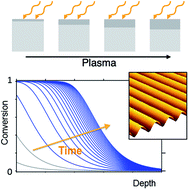Wavefront kinetics of plasma oxidation of polydimethylsiloxane: limits for sub-μm wrinkling†
Abstract
We investigate the surface plasma oxidation of polydimethylsiloxane (PDMS) elastomers and its implication for the morphologies attainable by wrinkling of glassy-elastomer ‘bilayers’. The kinetics of glassy skin formation is found to follow a logarithmic dependence with plasma exposure time t and, for various plasma intensities I, the relevant control variable is shown to be dose (≡I × t). We model the mechanism and kinetics of glassy film formation by plasma oxidation with a frontal propagation coarse-grained model, describing the spatio-temporal evolution of a conversion order parameter (ϕ) orthogonal to the film surface. The model is validated by X-ray reflectivity experiments, which confirm the logarithmic growth and quantify the initial growth of a transient, incomplete, skin layer during the early stage of plasma exposure. Three regimes are identified as (I) induction, (II) formation and (III) propagation with a combination of X-ray and wrinkling experiments. The simultaneous increase in thickness and skin mechanical modulus is found to be responsible for an unexpected minimum wavelength λmin attainable, which depends on critical strain εc and is ultimately limited by mechanical failure of the elastomer (λmin ≃ 140 nm is demonstrated at ε = 200%). We conclude by establishing a 1D surface morphology diagram, in terms of wavelength λ and amplitude A, limitations and capabilities for producing highly ordered (sub-)micropatterns over macroscopic areas using plasma oxidised PDMS under uniaxial strain.


 Please wait while we load your content...
Please wait while we load your content...